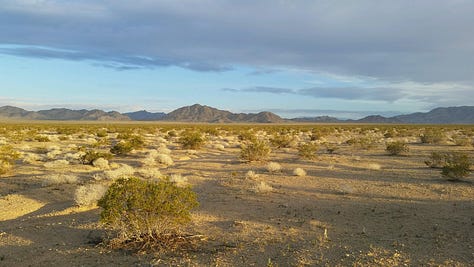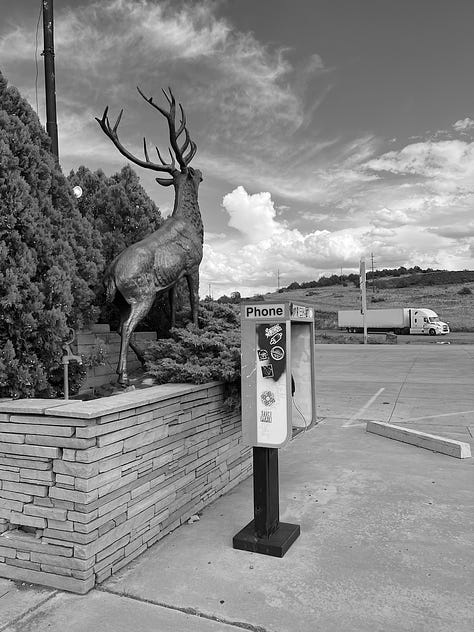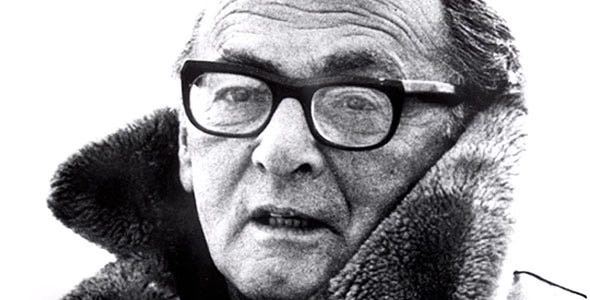The Road Trip Secret Self
Reflections on the desert Southwest, Eric Kohner's interview, and artistic intuition
I love solo road trips. I get this from my dad, a longing for the open road and the vastness of the Southwest. Road trips are a mindset, right? You can either begrudge the time it takes to get from here to there, impatient for the action at the destination, or you can settle in and enjoy the ride.
The other day I drove the I-40 from Flagstaff, Ariz., back to Las Vegas, a route that I’ve traveled probably a hundred times. To begin, you descend 6,000 feet from the Colorado Plateau, with its ponderosa pines and volcanic cinder rocks, into the Mojave Desert. The Mojave can be stark and ugly in places, barren as a moonscape, a land that smells faintly like the sulphur of rotten eggs. But even the more merciful stretches seem uninhabitable. Occasionally you pass a string of rickety mailboxes fronting a turnoff to a dirt road, and you pass tiny gas stations, architectural throwbacks from the mid-century that still seem endearing despite of, or because of, their decay. At least one wants to sell you jerky. You pass the Ash Fork Trading Post with vintage Navajo jewelry and Pendleton blankets and a strange, unlit counter displaying a variety of Saran-wrapped fudge. You pass a semi-truck lodged high on a cliff that says “Trump” in skinny, shaky, hand-painted red letters. How did that truck get there, and by whom? Have they changed their minds about him? No chance. You pass road kill, coyotes and rabbits and the occasional rattler. You drive through Kingman where you stop at the Cracker Barrel to pee and McDonald’s to buy a Diet Coke and sometimes also a small order of fries.



You hit the 100-mile stretch of pitted and crumbling road from Kingman to Vegas during the golden hour before the sun sets, when the desert glows through the dusty and bug-splattered windshield, shades of copper and russet and chartreuse, and the road is like a strand of liquid silver, and the wide canyons and rolling hills are layer upon layer of indigo and violet, bass clef to the desert’s treble, purple mountain majesties just like in the song says.
Playlists are important on road trips. Podcasts or audio books are good, too, if you’ve got a ways to go and time to kill. The stories can transport you the way a Netflix binge eats up six hours on the couch. But if you want to stay in the moment, you need a playlist. This trip, I probably listened a dozen times to the biz colletti cover of Bruce Springsteen’s “Dancing in the Dark,” which a friend pointed out as the breathy, dreamy soundtrack closing a recent episode of The Morning Show, a silly and pulpy drama that we both watch as a guilty pleasure. That song, man. If you don’t remember, or never knew, apparently Springsteen penned it one stir-crazy night at the behest of his manager who insisted Born in the U.S.A. needed one more sure-fire hit. Springsteen wrote about exactly that, the pressures of the creative process, the restlessness of trying to mine for something good, and of being so sick of the self that you want to give up but you know you can’t or won’t—“man, I ain’t gettin’ nowhere / I’m just livin’ in a dump like this / There’s somethin’ happenin’ somewhere / Baby, I just know that there is.”


Last week I published an interview with Eric Kohner, an actor-turned-coach who is also my coach, and who has developed leadership programs in which he teaches the skills and techniques of acting to the corporate sector. The idea is that ordinary people, the non-performative among us, are also making up who we want to be in the world—but with less intention and awareness than we are capable of. Thus, if we are, all of us, creating “roles” for ourselves, then let’s learn how to design them with skill. Let’s broaden our range.
I’m a different person on the road, in the crosshairs of what I’m leaving and heading toward, and I fill the interstitial space with wildness and boldness. On the road I become, if not someone else, a secret self. I’m Stevie Nicks. I’m Princess Leia. I’m Hunter S. Thompson. I’ve never put it together before now, but I also love road trip films, even the sappy ones. Here’s the Criterion list of the best road trip films, and here’s Rotten Tomato’s. No surprise, there’s only a little crossover. Both have gems.
Of course, being a different person in my CR-V—with a dream catcher swaying from the rear view mirror, bike rack in the back, me trying to find the harmony in every song—is easier than, say, becoming someone who accepts life on life’s terms, or lets go of worries in the middle of the night, or speaks up in the face of injustice, or knows how to skillfully navigate conflict. No one is saying this work is easy. Just that we are all capable of more.
Eric also mentioned the Meisner technique. Sanford Meisner on Acting is a fabulous book if you are curious to learn more. (I recommend the audio version because so much of the technique is embedded in the subtleties of the actors’ exchanges and the interplay between Sandy and the class.) Listen with courage and compassion because some of how they speak of gender and identity is reminiscent of times past. But if you’re a serious student of human relationships, it is a masterclass on how to tap into different knowledge centers in the body. We are like four-limbed relatives of the octopus with brains distributed throughout our beings: we can learn to pay attention using all of our faculties. What does that get you? Connection. Authenticity. Fire. Transcending, as Meisner put it, one’s own scared self.
The ability to drop into a sense of intuition is one distinction of a great coach. Some people call it “gut” but I don’t because, for me, it shows up all over, like an awareness or energy just outside of myself, the way the hairs on your arms might stand up but think even more abstract. Regardless of how it manifests, tapping into one’s intuitive truth is also how Springsteen can write lyrics that are so simple yet profound, and also what makes a cover song resonate. It’s why we’re curious about Billy Crudup as Cory Ellison on The Morning Show. It’s what can be unforgettable about a great boss years after you’ve stopped working for them. It’s why you can feel so moved by a painting that it resembles heartbreak. It’s not head knowledge—not something you can absorb from an article in the Harvard Business Review or the latest management book, however smart and credentialed the authors may be. It’s an ongoing study and a practice. It is an art.
Finally, hello. If you are a new reader and you’ve made it this far, welcome! My goal is to publish weekly and alternate between interviews, reflections, and other useful news on the industry and practice of coaching. I hope you continue to find it engaging, and will consider sharing Cento with your network. Oh, and if there’s someone you’d like to see profiled, or if you have a question or idea for a topic, please shoot me an email and I’ll see what I can do. I’m very open to suggestions. Again, thank you, and happy trails.






